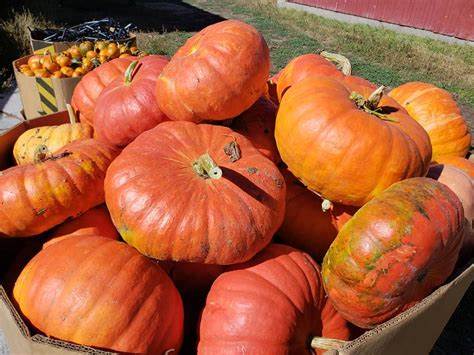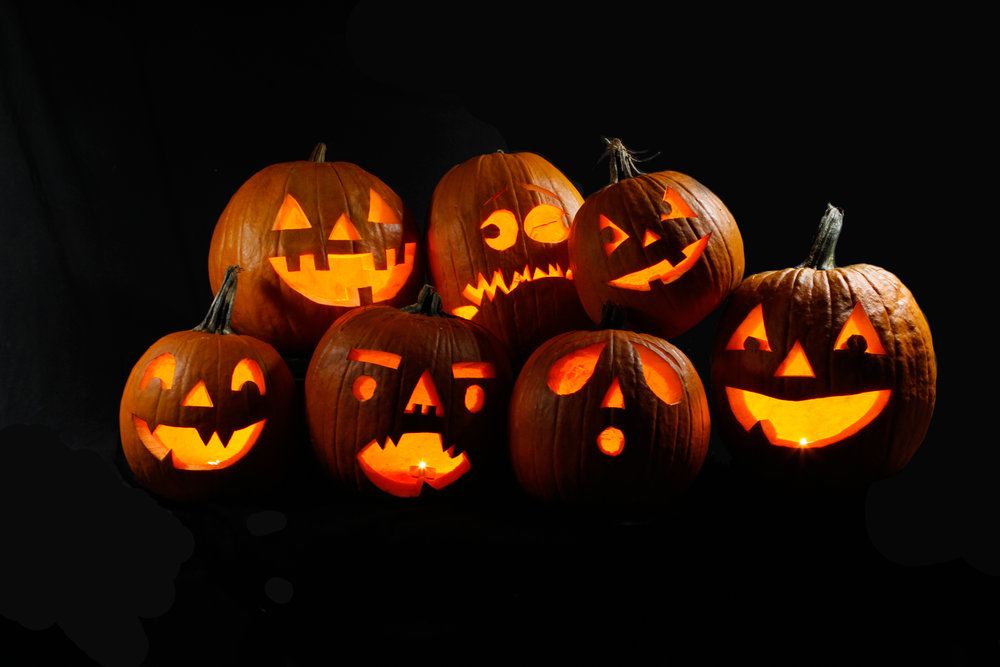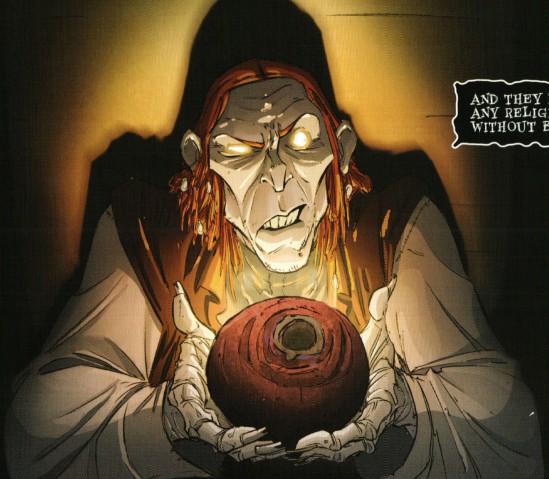Foods of the Americas: The ‘Great Pumpkin,’ Jack O’Lanterns and vampires!
Editor’s note: Michelle’s Foods of The Americas series on squash continues with Part III, a history of mythology associated with squash, and how pumpkin, originating in the Americas, is today internationally loved and adorned. To read Part I, click here, and to read Part II, click here!
By Michelle Bakeman
As the autumn months are almost upon our friends back home in the Northern Hemisphere, what better time to ponder the history of squash and pumpkins as we recall fondly our memories of Halloween and Thanksgiving?
Squash is one of our oldest cultivated crops. Originating in the Americas, it quickly ventured to faraway empires after its introduction to Europeans in the 16th century. This was due to the fact that South America was visited, during its colonial period, by ships coming from ports all around the globe.

Michelle Bakeman
While most squash varieties reached Europe via direct route from the Americas, others journeyed first to Australia, Asia, or Africa where their migrant seeds found homes in new soils and ultimately produced new landraces. A small turban squash coming from China made its debut in Europe in 1885 and there was given the name “Red China” as people naturally assumed that its origin was to the East. Moreover, throughout the 17th and 18th centuries, India became a hotbed of squash cultivation as did Australia, but it was in Africa where C. Maxima flourished so successfully that by the 19th century it was generally accepted that Africa must have been its place of birth.
Regardless of any misconceptions about the origin of the fruit, however, history tells us that Europeans were quickly collecting the squashes that came to their shores and across their lands and using them to cultivate their own new varieties. Today we have hundreds of types of squash to choose from, and they are grown all over the world, prized as much for their quirky-looking, colorful facades as for their range of flavors and textures.
Surprisingly, there is very little historical mention of squash as being associated with illness or death in humans. Because of this, the fruit was spared the kind of negative reputation tainting other New World crops like the potato and the tomato, both of which were feared for centuries after their introduction to the Old World. Given that Europe’s 16th-century inhabitants were already familiar with cucurbits such as the cucumber and the watermelon, perhaps the new, likewise water-rich fruits that bore such a close resemblance to these known trusted foods, therefore, escaped rampant slander and persecution. The consumption of squash in Europe, then, in general, caused no major scandals, but as with all things, of course, there was one exception, and that exception was curiously associated with vampirism.
There was a scholar named Tatomir Vukanovic (1907-1997), a Serbian-born ethnologist and historian, who focused his research on the history, culture, and folklore of the Balkans in southeastern Europe. More specifically, he studied the Roma and Serb “gypsy” inhabitants of Yugoslavia. With regard to the significance of squash in the lives of these people, Vukanovic documented a rather interesting discovery that links pumpkins and watermelons to their cultural phobia of vampires. Several years after traveling around Serbia between 1933 and 1948, he wrote the following in the Journal of the Gypsy Lore Society:
The belief in vampires of plant origin occurs among Gs. [Gypsies] who belong to the Mosl. faith in KM [Kosovo-Metohija]. According to them there are only two plants which are regarded as likely to turn into vampires: pumpkins of every kind and water-melons. And the change takes place when they are ‘fighting one another.’ In Podrima and Prizrenski Podgor they consider this transformation occurs if these vegetables have been kept for more than ten days: then the gathered pumpkins stir all by themselves and make a sound like ‘brrrl, brrrl, brrrl!’ and begin to shake themselves. It is also believed that sometimes a trace of blood can be seen on the pumpkin, and the Gs. then say it has become a vampire. These pumpkins and melons go round the houses, stables, and rooms at night, all by themselves, and do harm to people. But it is thought that they cannot do great damage to folk, so people are not very afraid of this kind of vampire.
Among the Mosl. Gs. in the village of Pirani (also in Podrima) it is believed that if pumpkins are kept after Christmas they turn into vampires, while the Lešani Gs. think that this phenomenon occurs if a pumpkin used as a syphon, when ripe and dry, stays unopened for three years.
Vampires of vegetable origin are believed to have the same shape and appearance as the original plant.
The Gs. in KM. destroy pumpkins and melons which have become vampires … by plunging them into a pot of boiling water, which is then poured away, the vegetables being afterwards scrubbed by a broom and then thrown away, and the broom burned.”

Coincidentally, in other countries across the globe, the pumpkin also became associated with the macabre, absorbed into traditions having to do with the blending of the world of the living and the world of the dead, traditions related to that most beloved of holidays, Halloween.
Halloween has its roots in an ancient Gaelic festival called Samhain. This pagan Celt celebration marked the end of the harvest and at the same time the beginning of the six months of the year that were filled with darkness, a time when the wall that separated the living and dead worlds was thin. It was this frailty that made human beings vulnerable to the creatures of the spirit world, which naturally could be evil. What’s more, on the night of the festival, Lord Samhain, the lord of darkness himself, would wander the villages in search of souls to steal. In an effort to defend themselves against the monsters, people began dressing up as one of them, as a fake ghost, goblin, or demon could perhaps, scare the real ones away. As paganism was slowly usurped by Christianity, the festival of Samhain eventually meshed with All Hallows’ Evening, denoted by the Catholic calendar as the night before the day that honors the dead, All Saints’ Day (also called Hallowmas). But how did pumpkins enter the scene, transformed into Jack O’Lanterns and lighting the porches of so many homes every year on October 31st? Well, clearly the story of Halloween does not end with the melding of pagan and Christian rituals. In giving thanks for the wicked wonder that is the Jack O’Lantern, we turn to the Irish immigrants to the New World. Irish folklore is replete with legends about a naughty old drunkard named Stingy Jack, who enjoyed taunting everyone, including the Devil. For the Irish, the tradition of the Jack O’Lantern started hundreds of years ago with Stingy Jack, as divulged in the following story:

One day, he (Stingy Jack) tricked the Devil into climbing up an apple tree. After the Devil climbed up the tree, Stingy Jack hurriedly placed crosses around the tree’s trunk. Unable to touch a cross, the Devil was stuck in the tree. Stingy Jack made the Devil promise him not to take his soul when he died. Once the Devil promised not to take his soul, Stingy Jack removed the crosses, and the Devil climbed down out of the apple tree.
Many years later, Jack died. He went to the pearly gates of Heaven and was told by Saint Peter that he was mean and cruel and had led a miserable, worthless life on earth. Stingy Jack was not allowed to enter Heaven. He then went down to Hell and stood before the Devil. The Devil kept his promise and would not allow him to enter Hell. Now Jack was scared. He had nowhere to go but to wander about forever in the dark Netherworld between Heaven and Hell. He asked the Devil how he could leave, as there was no light. The Devil tossed him an ember from the flames of Hell to help him light his way. Jack had a turnip with him. It was one of his favorite foods, and he always carried one. Jack hollowed out the turnip and placed the ember the Devil had given him inside it. From that day onward, Stingy Jack roamed the earth without a resting place, lighting his way as he went with his ‘Jack O’Lantern’.
On all Hallows’ Eve, the Irish hollowed out turnips, rutabagas, gourds, potatoes and beets. They placed a light in them to ward off evil spirits and keep Stingy Jack away. These were the original Jack O’Lanterns. In the 1800’s waves of Irish immigrants came to America during the Great Famine. The Irish immigrants quickly discovered that pumpkins were bigger and easier to carve out, so they used pumpkins for Jack O’Lanterns.
While the legends of Stingy Jack may have faded into the past for some or were perhaps never even known to many, in modern times, families all over North America carve and light up pumpkins every year, perpetuating their Halloween traditions. It is a time for artistically-inclined people to showcase their talents, and in small towns everywhere in the U.S., folks take pride in entering their sculpted pumpkins in contests, eager to be declared the local victors.
So popular are pumpkin carving competitions these days, that even the engineers at NASA’s Jet Proportion Laboratory have been hosting their own competiti0n for the past seven years. They use their special skills to bring life to the pumpkins, often giving them moveable parts, rigging them to spin around, and even transforming them into characters like E.T. The contests don’t stop with NASA or even with carvings. Every autumn, farmers across the world proudly vie for the bragging rights to claim to have grown the year’s heaviest pumpkin.

Mathias Willemijns holds up a Belgian flag next to his record-smashing pumpkin. (Thomas Kienzle/Agence France-Presse/Getty Images)
To date, the world record for the heftiest pumpkin was set in October 2016 by a Belgian man named Mathias Willemijns, who cultivated a monster pumpkin of 2,624 pounds. For the past 45 years on Columbus Day, American growers have gathered in California’s Half Moon Bay to show off their gargantuan pumpkins. And for the year 2019, their Annual World Pumpkin Weigh-Off is offering a $30,000 mega-prize to the person who can present a pumpkin weighing in at more than Willemijns’ 2,624 pound record holder. The contest is sanctioned by an organization called the Great Pumpkin Commonwealth, which oversees more than 70 official giant pumpkin weigh stations all over the world for competitions such as the one at Half Moon Bay, which also awards a cash prize for the most beautiful pumpkin. This competition is followed by a two-day pumpkin festival, where folks from all over the West Coast gather to revel in their fervent pumpkin adoration.
The pumpkin, then, could easily be deemed the most beloved of all squashes, given its tendency toward popular culture fame and its uncanny ability to transform itself into the tastiest of pies. But the truth is, squashes of all shapes, sizes, and colors are unique in their own right to the world of fruits and vegetables for one very important reason; their mild, slightly sweet flavors make them an ideal component in dishes from every cuisine on the planet. They can be elegantly and delectably adorned with the spices and sauces found in India, Africa, Spain, France, Mexico, China, Japan, Peru, in effect, everywhere. Nestled among the other ingredients on the plate they bring to them their vitamin-rich brilliance, and given that we eat first with our eyes, the squashes draw us to them time and again, flaunting the spectrum of their fleshy hues in an effort to tempt us to use them to temporarily squelch our insatiable hunger. They are the quintessential gift of Mother Nature and the joy of any farmer, who looks out across his fields at harvest time,
Where crook-necks are coiling and yellow fruit shines,
And the sun of September melts down on his vines.
–John Greenleaf Whittier
Sources:
Halloween: A History of All Hollows Eve, from Samhain to trick-or-treat,
by Tom Chivers, October 2009, The Telegraph
Pumpkin Nook, Jack O’Lanterns and the Tale of Stingy Jack
The Vampire; published in four parts in the Journal of Gypsy Lore
Society from 1957 to 1960, by TP Vukanovic, reprinted in Vampires of the
Slavs, Slavica Publishers, Columbus, Ohio, 1976.
The Cambridge World History of Food, Volume 1, edited by Kenneth F.
Kiple, Kriemhild Conee Ornelas, Cambridge University Press, 2000.
_______________________________________
Michelle Bakeman has a bachelor’s degree from the University of Virginia in Spanish and Latin American Studies. She is also a graduate of the Culinary Arts Institute of Louisiana. She has been a chef for twenty-two years, has owned and operated several restaurants, and has been a teacher for sixteen years. She moved to Cuenca in 2013.





















